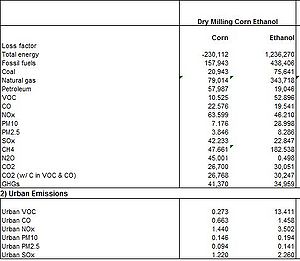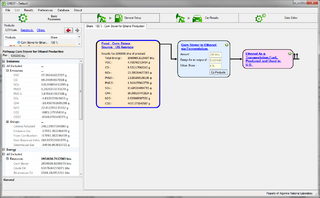Ethanol: Difference between revisions
| Line 28: | Line 28: | ||
In the case of sugar cane ethanol and corn acetone the main input is not one million btu, so one must subtract the portion of the energy represented by the main input. This will be specified as sugar cane or corn respectively in the results. It must be stressed that in regards to the main input what is done in Greet Excel or what is done in Greet .net are both right. It is simply two different ways to interpret the same data. | In the case of sugar cane ethanol and corn acetone the main input is not one million btu, so one must subtract the portion of the energy represented by the main input. This will be specified as sugar cane or corn respectively in the Greet.net results. It must be stressed that in regards to the main input what is done in Greet Excel or what is done in Greet .net are both right. It is simply two different ways to interpret the same data. | ||
Revision as of 15:30, March 21, 2012
Introduction/Preface
The implementation of the .net version of Greet required us to model the data in Greet excel. This includes the ETOH sheet of Greet excel. The ETOH data sheet contains many calculations that are not done in other portions of Greet. The purpose of this document is to summarize these differences, and explain our execution of this portion of our .net model in further detail.
For the most part the ETOH data is implemented in the same manner as all the other data. However, their are some topics that need clarification for users and scientists alike. The main points to focus on are feed & fuel, main input, yields, and co-products.
Feed & Fuel
In Greet excel their is a split in the data results between feed & fuel. Fuel refer to the fuel being fuel being produced. This is a final product such as Ethanol, Fisher Tropsh Diesel, Conventional Gasoline etc. The feed, or feed stock, refers to the main resource used to produce this fuel. For example for Ethanol it can be corn. In the case of Conventional Gasoline it will be crude. In Greet excel the results are split between these two categories. For example in ETOH they will show emission output and energy consumption for the corn used to make the Ethanol, and then in a separate column show the energy and emissions corresponding to Ethanol. Examples of feed and fuel in Greet excel are shown the right.
In our implementation of Greet .net we do not formally split fuel from feed. We total all our data on a life cycle basis. The final results we generated encompass the total life of the fuel not just the feed half and the fuel half, but both. However, a user can easily obtain the energy and emission data pertaining to a certain step of the fuels life.
The best way this can be shown is by example. Below is a screen shot of Corn Stover to Ethanol from Greet .net. The results shown to the left are for the final process, the transportation process. Since this is the final process the results shown are for the entire life cycle for the fuel as described above. If a user wishes to obtain the data for the fuels life right before the transportation process they can press the "Corn Stover to Ethanol via Fermentation" process, and greet will show data for the fuels life up to that point.
In addition it should be noted that at the beginning of this pathway their is a "Feed" of Corn Stover. This is analogous to the fuel & feed split in Greet excel. By hovering your mouse over the "Feed" it expands reveling the data as shown below. By click the "Feed: Corn Stover" hyperlink Greet will open up the Corn stover mix and reveal the pathways and processes that generate this data. Once again a user can click on these to view the energies and emissions corresponding to different stages of the fuels life.
Main Input
The main input refers the energy content of the initial amount of resource put into a fuels production life. For example the main input of most Ethanol pathways would be corn. In the case of Compressed Natural Gas the main input would be some initial amount of natural gas. Both Greet Excel and Greet.net incorporate this input into their life cycle analyses. However, the way it is accounted for in each is different. In the .net model of Greet is always added to the results. However, this is not the case for Greet excel.
In the ETOH sheet of Greet excel it is not accounted for in the final results. This can easily be noted by comparing results between the two models. To compare Greet Excel ETOH data to Greet.net one must add the results of the Fuel and the Feed because as described above Greet .net does not make that division. Once added together one will notice that the emissions (VOC, CO, NOx, PM10, SOx, etc.) are relatively close in value. However, the energy is off by a factor of a million btu. This is because in Greet.net we include the initial one million but from the main input, but in Greet Excel they do not. To compare the results simply add a million to excel or subtract a million for the .net results.
In the case of sugar cane ethanol and corn acetone the main input is not one million btu, so one must subtract the portion of the energy represented by the main input. This will be specified as sugar cane or corn respectively in the Greet.net results. It must be stressed that in regards to the main input what is done in Greet Excel or what is done in Greet .net are both right. It is simply two different ways to interpret the same data.

